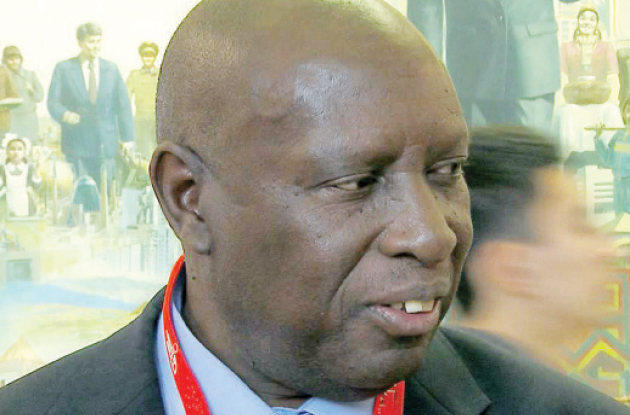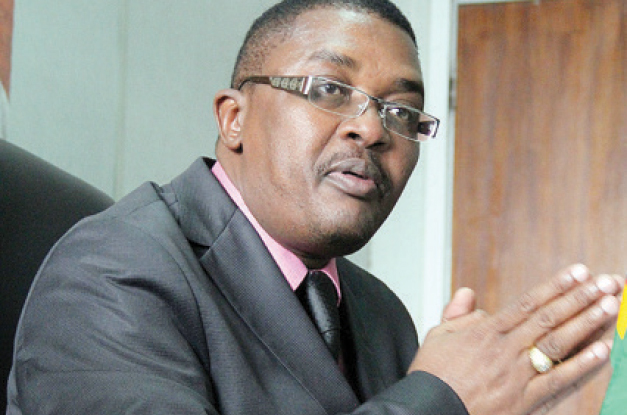Energy Minister’s speech in Parly in full

The Minister of Energy and Power Development Samuel Undenge on Tuesday addressed the National Assembly on the current power crisis.
Below is his statement in full:
Thank you Mr. Speaker, may I take this opportunity to address the House on the current power situation.
Mr Speaker Sir, Hon. Members of Parliament in this august House are well aware that the country is facing power shortages and this has been a phenomenon since 2004. Most of our power is supplied by ZESA Holdings which runs five power stations. These are namely Kariba South Hydro Power Station which generates 750MW; Hwange Thermal Power Station with an installed capacity of 920MW and three small plants which are Harare Thermal Power Station; Bulawayo Thermal Power Station and Munyati Power Station with a total installed capacity of 320MW.
Hon. members, the three small thermal power stations were commissioned between 1946 and 1958 and have since reached their designed life. They are now in a deteriorated state with most of the plants requiring either life extension measures or complete replacement. It will be recalled that at one point all three were once decommissioned only to be refined again. This is why we have decided to refurbish them. The last unit at Hwange was commissioned in 1987 and hence, is more than 25 years which generally is the designed life of thermal power plants.
You should therefore, understand the frequent breakdowns which we experience at the plants although of late, this has drastically worsened. Hon. members, the power demand reached a historic peak of 2,200MW in 1996 and fortunately, during those days we could easily import from the region and we met this demand. Our maximum demand is therefore more or less around 2,000MW and this is achieved only in the winter period when there is increased demand for heating as well as irrigation of wheat. Our current maximum demand is around 1,610MW due to low capacity utilisation in industry and mining compared to 1996.
The prevailing situation at Kariba was predicted around April, this is the month when the lake is filled to its maximum capacity. The Zambezi River Authority which manages both the lake and the dam on behalf of Zimbabwe and Zambia alerted the two governments of the low water flows into the lake and the need to sparingly use the water. It should be noted that the catchment area of the Zambezi River spans up to the Democratic Republic of Congo (DRC) and hence, the water flows are not determined by our own rainfall patterns alone.
To this day, water is still flowing into the Zambezi river from the north but we are drawing more water than what is flowing in, hence the continued decline in the water level.
Hon. members, we did not ignore the recommendations of the Zambezi River Authority. As we were approaching the high demand winter period, we took a conscious decision to run the plant at full capacity in winter and then reduce the power output after this period so as not to drastically disrupt the winter crop. I gave weekly briefings on the water situation at Kariba to Cabinet.
Mr Speaker, scheduled maintenance works at Hwange were also suspended during winter. Load shedding was therefore very minimum in winter and you are all witness to this. The prolonging of scheduled maintenance at Hwange, however came at a cost which we are now experiencing. Now that we are past the high demand period, we have reduced the water consumption to allow for an average generation of 475MW at Kariba. At this generation level, we will not surpass our allocated share for the year 2015. The suspended maintenance works have been re-scheduled such that as I speak, Unit 1 at Hwange Power Station has been out for more than a month to allow for the critical maintenance work.
The unit should return to service in the next two weeks. Barring the unpredictable breakdowns – we expect to have five units at Hwange running most of the time giving us an average of 600MW. The expected supply will average 1,195 megawatts inclusive of the usual 70 mega watts from the small plants and the same 50 megawatts which we import from Mozambique. The capacity shortfall at peak will then be 400 megawatts. However, we have some unavoidable contractual export obligations of 80 mega watts to Namibia.
Honourable members, Mr Speaker Sir, it is clear from the above facts that load-shedding is unavoidable. The intensity however depends on the performance of Hwange Power Station. We are now working on a raft of measures for us, at least to revert to the winter period load-shedding schedules. The measures which we are taking include the following:-
- Generation of power at the four thermal power stations, particularly at Hwange Power Station must be maintained at very high levels so as to supplement the limited generation at Kariba Hydro Power Station.
- Noting that there are some large users of power such as Mimosa, Unki, Zimplats, ZIMASCO, Zim Alloys and Afroshin et cetera, these are to be asked by the Zimbabwe Electricity Supply Authority (Zesa) to drop load by up to 25 percent on the basis of existing contracts. It would be up to these large power users to decide on which areas of the operations to load-shed. This is expected to yield 25 megawatts.
- We will also ask other departments including of course, ZNA and ZRP to load-shed what we call non-critical and residential loads at the institutions so that we share the burden.
- We will also undertake increased power saving awareness campaigns for commercial offices and premises, government buildings and schools so that they switch off as befits the current situation.
- The 40 megawatts which we are currently availing to Sable Chemicals, we are going to divert it to other users. This alone, if we take such a measure, we are going to reduce Harare’s load-shedding to about six hours per day compared to the current 18 hours. So that is going to be drastically reduced.
- Mr Speaker Sir, it is conceded that the local production of ammonium nitrate would stop as a result of this action. The product will have to be imported. Let me point out at this juncture that energy sector is a liberalised one. We also encourage our big companies to also import power wherever they can source it from, being operating in a liberalised market.
- We are also going to distribute or share the load-shedding equally, for example, in the CBD areas; we have noticed that if we have a roll-out of 30 minutes black-outs, we are going to save a lot of power that way without disrupting any life.
- We are exploring the possibility of importing emergency from the region. In fact, we are negotiating in the region. There is what is called ‘the day-ahead market’ where we can arrange excess power using what we call the Southern African Power Pool of which we are a member; and that Southern African Power Pool is going to extend to East Africa as well.
- The next measure which we encourage is the switching off of geysers during peak demand period using the ripple control system and we reckon that such a measure will save and release 42 megawatts into households and industry. Perhaps, most of you were not aware of this and being Parliament, you have the privilege to know. In the 1980s, ZESA at peak demand had a system of just switching off your geysers without you noticing anything. We call it “the ripple control system”, but of course now the gadgets at most homes have expired. So we are going to install such systems so that during those peak periods, we switch off the geysers for a short time and it will not affect your daily lives.
- I have already talked about the South African Power Pool and the day-ahead market. Mr Speaker, you may be aware that on the 30th September, we launched the solar-geyser water heating system in which there are plans to replace existing geysers with solar powered geysers. That is for all the existing households.
- For new housing developments we are going to make it mandatory that they should be installed with solar geysers. This is a widely practiced system, Mr. Speaker, Sir, if you go to Johannesburg, when you leave the Airport; you find that every household is installed with a solar geyser. This system alone is going to save 300 megawatts by the time it is completed and that is equivalent to building a new power station, it is equivalent to what we call a virtual power station.
- The beauty of this programme is that as we install the solar geysers, you will be actually taking the load from the national grid. In the first 6 months, when we start implementing the programme, we can move up to 30 megawatts which we will save. By the end of the first two years, we reckon we would have saved even 100 megawatts. By the time we complete the programme, we would have saved around 300 megawatts.
- Mr Speaker, Sir, you will agree with me that energy is the main enabler of the ZIM-ASSET goals; we are therefore making every effort to increase its availability. The measures I have alluded to above are immediate measures. We have also identified medium quick win projects which we are vigorously pursuing and are well on the way to being implemented. These measures should add up to 340 megawatts to the national grid within the next 36 months. The first one includes the re-powering of the Bulawayo Thermal Power Station where the Government of Zimbabwe has already secured a line of credit valued at US$87 million dollars from the Government of India.
- The re-powering works will add 60 megawatts into the grid and will take 24 months. We also have the Harare re-powering projects which will costs US$70,2 million and of course, we were expecting financing from the India Exim Bank. This project will take 24 months to complete and it will add 90 megawatts to the national grid. The Munyati re-powering project went to tender and adjudication is currently taking place, the construction period will be 24 months and it will add 70 megawatts to the national grid.
- Mr Speaker, Sir, we also have the Mutare emergency peaking plant which will run on diesel or gas, it is a peaking plant which will be operated at peak demand and it will produce 120 megawatts. The project costs will be US$92 million. The company which won the tender is doing final negotiations with ZESA so that it commences the construction. The construction period is going to take about 18 months.
- In addition, Mr Speaker, the nation is already aware of the Kariba Hydro Power Station, of which work is under way to build two new 150 megawatts units. This will add 300 megawatts to the national grid; we expect the first unit to be completed by the end of 2017, and the second unit, in early 2018. I think hon. members here, some of you may have witnessed the ground breaking ceremony when it took place in 2014.
- We have the Hwange Thermal Power Station extension which will comprise unit 7 and 8. Each unit will produce 300 megawatts and the total will be 600 megawatts. There is also the Gairezi small hydro power plant in Nyanga which will produce 30 megawatts. Let me also take this opportunity Mr Speaker, Sir, to talk about the Batoka Hydro Power Plant. This is a project being jointly implemented by the Government of Zimbabwe and the government of Zambia. Feasibility studies have been done and we are now moving to the next stage of securing the contractors and the associated funding. The total generation, the power output as I said will be 2,400 megawatts to be shared equally by the two respective countries.
- As Government policy, we also encourage the private sector to participate in power generation under what we call Independent Power Producers. You can become an independent power producer, then sell your power to ZESA to the national grid; you will negotiate a power purchasing agreement with ZESA. So, anyone is free here to go and produce electricity, sell it to ZESA, which is one way of alleviating the power shortage.
- We have a series of people who have expressed interest to produce electricity under Independent Power Producers. The first one is the 600 megawatt project by China Africa Sunlight at the confluence of Gwai and Shangani Rivers. The other one is the 600 megawatt plant proposed by Southern Energy Thermal Power Station at Hwange; the other one is the Lusulu Thermal Power Station proposed at Binga. Of late, we have the Lubu Thermal Power Station again in Binga proposed by Sable Mining and a company from China called City. Then we have 2 400 megawatts at Sengwa Thermal Power Station in Gokwe, this is a private sector initiative.
- Apart from these mega schemes, we also have small hydro independent power projects. We have Pungwe B scheme which is already producing 15 mega watts but because of the water levels which are low in the dam, they are producing less than 4 mega watts. We also have Pungwe A, it produces 3 mega watts; there is also Duri and Nyamhingura. So, we encourage our investors to utilise the various rivers dotted around the country to produce power. In fact production of power is one of the lucrative sectors to invest in.
Mr. Speaker Sir, one way of reducing demand is to use the available power more efficiently, all sectors of the economy to use energy efficiently so as to reduce demand hence lessening the burden of load-shedding. As Government, we have adopted the following measures to reduce power demand now and in the medium term. The first measure we have banned the inefficient incandescent lighting, serving lighting. I am not talking about the Manicaland Air force Mom Hindi. So this will save 70 megawatts.
Mr. Speaker, incandescent lighting is one of the most inefficient systems and we have moved away from that technology to new technology. For example, led lights this saves electricity up to 70%. That simple switch on its own, cumulatively, we are going to save 70 megawatts. Another measure is developing energy efficient regulations for industry, mining, agriculture and the commercial sector. The other measure is that we are encouraging and promoting the use of LPG gas for cooking in order to conserve power.
Mr. Speaker, perhaps Zimbabwe is still one of the few countries which is relying on cooking using electricity energy. Most countries now use gas for cooking. That is why we are promoting the use of LPG gas. Zimbabwe also has enormous solar energy potential which if exploited, can supply approximately 10 000 gigawatt hours of electrical energy per year. We are looking at the potential, just looking at the sun, it is a God given resource when you measure the energy it can produce, that comes to 10 000 gigawatt hours.
Mr. Speaker Sir, Cabinet has taken a decision to increase the use of solar energy for electricity as well as provision of heat. The energy regulator has licenced a number of IPP solar projects with a total installed capacity of 150 megawatts, which are at various stages of development. In addition, the Government intends to install 300 megawatts of 100 megawatts each in Gwanda, Insukamini and Munyati. However, it has been two years and no tender has yet been awarded due to the bureaucratic processes at the State Procurement Board. I have since sought the authority of Cabinet to assess the technical and financial capacities of the tendering companies so that we short-list them and I go back to Cabinet with recommendations so that Government can take a decision.
Mr. Speaker, last week I left Parliament to prepare for the launching of the Solar Water Heating Programme. Water heating has been identified as one of the major components of electricity consumption. If you look at your bills, you find that you pay 40% for the electric geyser which you are using. That is why we have embarked on this programme of putting in solar geysers. It will benefit the consumers, ZESA and the country in the sense that we are going to save electricity and divert it to other areas where it is needed most.
I have also directed ZESA Enterprises to start on a programme to produce geysers. We are not going to have monopoly in the production of geysers. We want more players. There are already other players producing geysers, but because we are embarking on a massive programme, I have directed ZESA so that it also produces the geysers. I have decided to brief the House on the power situation in the country so that hon. members here present are well versed on the situation and go and take this information to their constituencies for the benefit of both the benign and the malign so that everyone in the country is well informed on what the current power situation is.
I would like to thank you Mr. Speaker










Comments